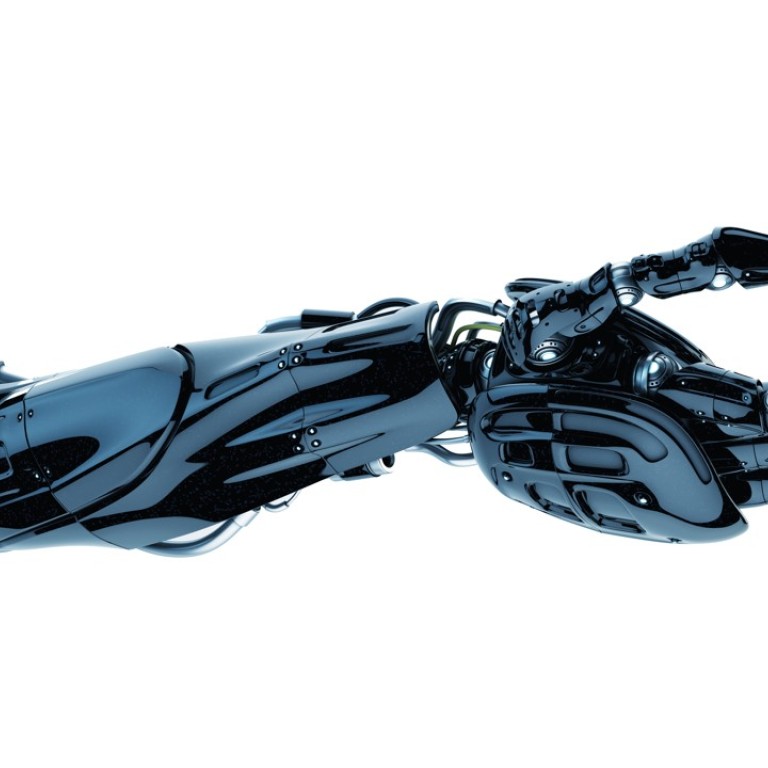This is not a sci-fi movie – the person walking next to you could be a cyborg

It sounds like the beginning of a science-fiction novel: scientists grow a living robot finger, that, when given a jolt of electricity, comes to life, bending to lift a ring off a hook. They refine the technology until they can grow an entire human/machine hybrid, which, with its superior strength, pure intelligence and lack of emotions, turns on its creators. From innocent robot digit comes the end of the human race.
But this is not fiction – at least not the robot finger. Scientists at the University of Tokyo have created a small robot from resin “bones” made on a 3D printer and living tissue, which they cultured from muscle precursor cells. When they apply a voltage to the living tissue, the muscle contracts, making the “finger” bend just like a real finger.
The professors behind this important breakthrough in biohybrid robotics say that they were inspired by science fiction.
“If we can combine more of these muscles into a single device, we should be able to reproduce the complex muscular interplay that allow hands, arms, and other parts of the body to function,” says Yuya Morimoto in a press release titled “Cometh the Cyborg”.
But cyborgs (that is, cybernetic organisms which are part man, part machine) are already here and walking among us. Way back in 2002, Professor Kevin Warwick, at that time based at the University of Reading, UK, had a Braingate electrode array directly implanted into his nervous system. The implant transferred signals via the internet, and through this he was able to control a bionic arm. The implanting of a chip in his wife’s arm also resulted in the first direct and purely electronic communication between the nervous systems of two humans.
Warwick, often called the world’s first cyborg, has described enhancing the human body with electronics as the “next evolutionary step” and said that, in a future in which humanity will be competing with intelligent machines, “there is no way I want to stay a mere human”.
Colour-blind artist Neil Harbisson claims to be the world’s first legally recognised cyborg. In 2004, he had an antenna permanently implanted into the back of his skull. The antenna, which loops over his head to his forehead like an errant telephone headpiece, translates the colour spectrum into musical notes that he hears as vibrations inside his head. (Blue, for instance, is middle C.) He also “hears” colours that are invisible to the human eye, such as infrareds and ultraviolets, meaning he has not just replaced a missing sense, but extended it.
The antenna also enables an internet connection, so Harbisson can receive colour sensations from other sensors or satellites. In a performance in 2014, passers-by in Times Square, New York, painted coloured stripes onto a canvas. The sound waves were sent over the internet directly into his brain and he painted the same colour stripes in front of an audience 10 blocks away.
The antenna appears in Harbisson’s passport photo, approved after weeks of discussion with the British passport office, which officially, according to him, confirmed his cyborg status.
Harbisson created the non-profit Cyborg Foundation in 2010 with Moon Ribas, his childhood friend. Ribas has an online seismic sensor implanted in her feet that allows her to feel earthquake vibrations. She performs live on stage, interpreting vibrations she feels from the earth through music and dance.
‘There is infinite hope, but not for us’
The Cyborg Foundation aims to help people become cyborgs, promote cyborg art and defend cyborg rights. Last year, Harbisson and Ribas created the Barcelona-based Transpecies Society with Manel Muñoz, who has barometric sensors that allow him to feel atmospheric pressure changes through vibrations in his ears. The society advocates for the freedom of self-design and aims to give a voice to non-human identities and the challenges they face.
“At the Transpecies Society, we see many people of 16, 17 and 18 years of age coming to see what we’re doing. They’ve been born with technology all around them; they’re not afraid to apply it in their body. The next decade will see lots of development in this field,” says 21-year-old Muñoz.
Besides cyborg artists and activists, thousands of bio-hackers, grinders and transhumanists are embracing man-machine fusions, especially in the US. These amateur body hackers, many of whom are long past their teens, are experimenting in garages with everything from night-vision eye drops made from a chemical found in deep-sea fish, to implanting magnets, typically on a fingertip, that allow them to pick up small metal objects or detect electromagnetic fields.
Implantable RFID tags, similar to those found in pets, are also popular. But the doyen of cyborgs, Warwick, says that he is disappointed in scientific progress that has occurred since his groundbreaking experiments almost two decades ago.
In a hundred years from now, though, we have no idea what the world will look like
“What Harbisson is doing is tremendously interesting, and he is profound. But he is not publishing academic papers or approaching his work in a scientific way,” he says. “While bio-hackers are often the ones pushing the field, they are taking great risks not working in a lab,” says Warwick.
“It’s been 16 years since my Braingate experiment, and while the same implant has been used in the US quite a few times for therapy, there’s not been another scientific experiment that is extended, or augmented, or enhanced what we have as humans. From a scientific point of view, that is a bit disappointing.”
Warwick’s experiments focused on robotics, and while developments in this field, such as autonomous vehicles, are set to be the next big commercial thing, today’s science has seen a dramatic push to develop artificial intelligence rather than cyborg technology, although these fields do overlap. Also, perhaps driven by uncomfortable questions about the ethics of bodily augmentation, the scientific community is focusing more on therapy.
“From the neurological point of view, the holy grail now is to understand more about what’s going on in the brain,” says Warwick. “Scientists are attaching electrodes to the outside of the brain, and the signals are being used to understand what’s going on inside the brain.”
Warwick is working with surgeons in Oxford on deep brain stimulation, which involves brain implants. “This gives us a picture of what’s going on in the brain. Then, using artificial intelligence, you can go about predicting the tremors a Parkinson’s patient would have, and counteracting them,” he says.
The same treatment is being used for certain cases of depression, Tourette’s syndrome and epilepsy. “Electronic medicine in the brain is much more effective and profound,” says Warwick.
There have also been advances in interfacing electronics and the skin. The Someya Group at the University of Tokyo, long at the forefront of wearables research, last year revealed their nanomesh, an electronic sheet of polyvinyl alcohol (PVA) fibres and conductive gold nanoparticles so thin that it can be directly laminated onto human skin, allowing the skin to breathe and sweat as normal. The interface is so seamless it could be said that skin has become electronic itself.
“Nanomesh has an enormous potential to non-invasively capture symptoms of chronic disease by detecting small changes that occur gradually over long periods,” says Professor Takao Someya, who leads the group. “Also, during sport, conventional sensors interfere with exercising. But with nanomesh, which is ultra-thin, lightweight and stretchable, you don’t even feel that you’re wearing it.”
Another application is human-machine interfacing. “For example, by putting a nanomesh electrode on your finger and tapping a panel with your fingertip, you can input characters,” he says.
But while advances are being made, particularly in the field of artificial intelligence – Tesla CEO Elon Musk recently announced that his enterprise, Neuralink, will within months reveal the ability to connect the human brain with a computer – we have a long way to go. It will perhaps take longer than we thought to progress from a robot finger to a Terminator-style cyborg, or upgrade ourselves into death-defying, hyper-human entities.
“I would echo [writer] Franz Kafka who told Max Brod, ‘There is infinite hope, but not for us’,” says Jason Pontin of US-based Flagship Pioneering, which creates, builds and funds companies that solve problems in health, sustainability and agriculture.
“I absolutely believe our brains will be augmented and our bodies will be made into glittering, functioning biological machines, and that we will live long lives with highly compressed morbidity. I think we’re beginning to see the technologies and science that will allow this. But I would be sceptical of anyone who promised you that we know how to do any of this at the moment.”
In a hundred years from now, though, we “have no idea what the world will look like”, Pontin adds.
Want to get genetic enhancement? Not so fast
If the second half of the last century was the digital age, in which we learned to programme machines, we have just begun the biological century, in which we will programme ourselves.
With the completion of the Human Genome Project, and the development of the CRISPR/Cas 9 technique, a highly flexible and accurate gene-editing tool that allows biologists to carry out genetic engineering at a very low cost on an unprecedented scale, we now have the science to be able to genetically manipulate our bodies. As Bill Gates has said, if he had grown up today, he
would be hacking biology instead of computers.
“The code of life is now readable and writable. That’s the big breakthrough,” says Jason Pontin of US-based Flagship Pioneering, which focuses on health, sustainability and agriculture.
The US remains the leading nation for fundamental biological insights that produce new modalities for treatment and drugs, while Europe is also strong on product-facing innovation. But Asia, particularly China, is racing ahead.
“Increasingly we’re looking East, and I expect China will be leading biomedical research in the future,” says Pontin. “They’re doing radical research that US universities won’t touch because of potential bad PR. Beijing’s Tsinghua University is particularly cutting-edge,” he says.
But despite the advances in genetics, Pontin says what we do know is far overshadowed by what still remains a mystery.
“To make up a figure, I would say we understand 2 per cent, maybe, of biology. It’s incredibly complex because it evolves, and everything we thought we knew at a very simplistic level 20 years ago has turned out to be fundamentally wrong. While radical things may happen to the children of
those now in their prime, I expect to die of the usual acute diseases, cancer or
heart disease, like everyone else,” he says.
Want more stories like this? Sign up here. Follow STYLE on Facebook, Instagram and Twitter

Professor Kevin Warwick from the UK had a Braingate electrode array directly implanted into his nervous system

